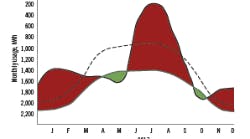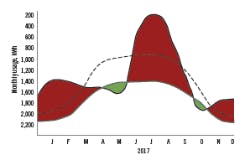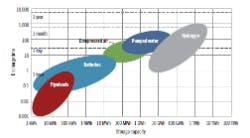Read Part 1: Is global warming significant? Is it caused by CO2?
Read Part 2: Effects we're seeing from melting ice, rising oceans and the "heat engine."
Read Part 3: How warming effects winds, precipitation, hurricanes and ocean currents
The process control principles described in the first three parts of this series have shown, that storage and transportation of intermittently available renewable energy is the key to stop climate change. The world seems to be reaching the same conclusion, as the storage market has grown 46% in 2017 and it is projected to grow ninefold in a decade, while the cost of storage will drop from 14 cents per kWh to around 3 cents per kWh. The cost of utility-scale lithium-ion storage systems have already dropped 29% in 2015, 26% in 2016 and 12% in 2017.
In this last column of the series, I review the energy storage technologies of both the past and the future, and outline the process control and automation challenges of both.
Gravity storage: The oldest methods of energy storage were gravitational, such as pumping water up into artificial lakes at high elevations and releasing it when electricity is needed. This method is used with fresh water in places like Austria and Switzerland, and in Germany using sea water on her shores. Gravity storage is limited to mountainous regions and limited in capacity, and does not allow for transportation of the stored energy.
A similar method is to compress air into underground chambers and release it when needed. The limitations of this method are similar to that of the hydroelectric one, but is even more limited and harder to implement.
Grid storage: Here, a two-directional electric meter sends excess solar electricity into the grid, and supplements solar electricity from the grid when it is insufficient. In our home, we have a 10 kW system (40 panels, 250 W each). It cost nothing, because it belongs to Solar City. All I agreed to is to purchase the electricity, which the system generates during the next 20 years, at 12.3 cents per kWh. (The cost of regular electricity from our grid is 24.1 cents per kWh). In 2017, our total consumption was 12,970 kWh, (7,957 kWh from solar), so last year we saved $938. We need another 5 kW capacity to convert completely to solar and were hoping to add this capacity this year, but to date, Solar City has been too busy to do it.
Figure 1: Total home electricity consumption and solar production of a 10 kW system in Connecticut shows flows to grid (green) and from grid (red). The dashed line predicts the effect of an additional 5 kW capacity.
On Figure 1, the green line shows our solar generation last year, and the solid black line shows our total consumption. The dotted line represents the expected solar generation when we add another 5 kW capacity. Last year’s solar generation exceeded our needs only in the spring and fall. In the summer, it needed to be supplemented because of air conditioning and pool pump loads, and in the winter because electric heat is added to the load and snow blockage reduces the insolation.
This "grid method" of storage is adequate in Connecticut because the use of renewable energy is small, but if is large (like in Germany), it creates problems, because when the sun comes out, electricity generation jumps and conventional powerplants can’t reduce output fast enough. Germany tried to overcome this problem by lowering the price of electricity, and even paying customers for using more during these periods, but it didn’t work (this "market-based" control loop failed).
Battery storage: When one talks about electricity storage, most people think of batteries. In the past few years, the cost of utility-size lithium-ion storage systems dropped drastically and larger-capacity battery farms are being built everywhere—for example, a 129 MWh facility in Jamestown, South Australia. Batteries are also used in electric cars and in private homes, but they are heavy, their capacity is small, their recharging time is long and they can’t provide transportation of large quantities of electricity (say, solar energy from the Sahara).
Therefore, for a couple of decades, the use of batteries is likely to rise, but when mankind fully converts to renewable energy, we will not have enough lithium to meet the demand (there is a total of some two billion motor vehicles in the world today).
Storage by my reversible fuel cell (RFC): In the 22nd century, the abbreviation RFC will probably be as common as PC is today, and a RFC will sit next to each home, just as a propane or oil tank does today. The permanent solution to our energy problems is to completely convert to renewable energy—to a solar-hydrogen economy. Naturally, the conversion requires storage and transportation of renewable energy, and hydrogen is the best substance to do that (Figure 2).
Figure 2: This comparison of capacity and discharge time ranges of various energy storage systems shows that hydrogen has the highest potential. Source: www.renewableenergyworld.com.
In the solar-hydrogen economy, solar energy will be collected in places like the Sahara and used to make hydrogen (from water) by electrolysis. Next, the hydrogen will be stored and transported, similarly to LNG today, and when reaching the users, it will either be burned as a fuel (as it is done today in space exploration rockets) or in fuel cells to generate electricity in cars or in private homes.
Homes will be built with solar-collector surfaces and during the day, the RFC (in its electrolyzer mode), will generate hydrogen from the excess solar energy. During the night (in its fuel cell mode), the RFC will generate electricity from the hydrogen to meet the needs of the home, including the charging the electric cars, etc. The level of the hydrogen in the storage tank will be automatically monitored, so when it reaches 90% , it will be trucked away and if it drops to 10%, the storage tank will be refilled, just as are the oil or propane tanks of today.
The controls of the RFC will be a challenge, and I will not explain it here, as I have already done that in the March issue.
In the four parts of this series, using traditional methods of process control analysis, I hope I have proved that climate change is real, it is caused by the burning of fossil fuels, and this trend can be reversed by our full conversion to renewable energy. I hope I have also shown that the Paris Agreement will not stop global warming because of the immense inertia and "double delayed" nature of this process. In other words, the proposed lowering of the CO2 concentration to only 345 ppmv is totally inadequate, and it must be lowered to the 280 ppmv level, which was the maximum that ever existed during the past half-million years.
Figure 3: A photo the author took in Iran (Persia) in November 2017 shows people walking in a large, completely dried-out riverbed.
I believe that we also can conclude that, due to the great heat capacity of the oceans, warming will take many decades, but once their temperature reaches the "tipping point" (the loss of the cooling effect of the melting polar ice), it will accelerate.
My process control-based evaluation of the time constants also suggests that the warming will occur faster in the tropics than elsewhere. This means that possibly as soon as the next couple of decades, the tropics will experience unprecedented temperature rises, water shortages (Figure 3) and weather events of biblical proportions, causing mass migrations, while the warming on the rest of the planet will take longer.
Climate change is probably the largest challenge that our overpopulated planet has ever faced. It will take a Manhattan Project-sized R&D effort to solve the technical challenges of converting from our fossil/nuclear-based energy economy to a renewable energy base. This conversion will require a new energy infrastructure, it will create immense numbers of jobs and many Silicon Valleys around the world, and its success will depend to a large extent on the contributions of our profession, that of the automation and control engineers.









